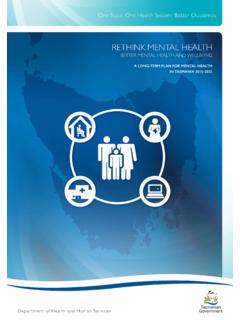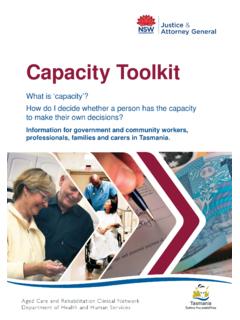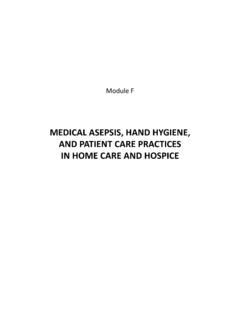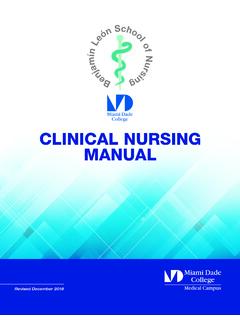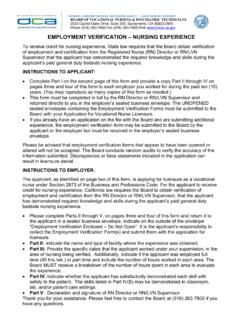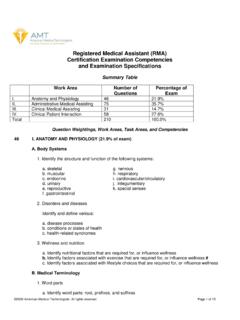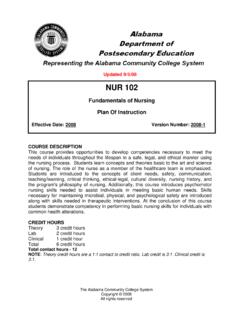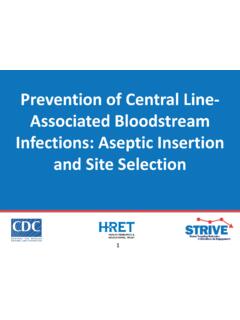Transcription of Aseptic non touch technique – a guide for healthcare …
1 Aseptic non touch technique a guide for healthcare workers Aseptic Non touch technique or ANTT is a tool used to prevent infections in healthcare settings. This guidance document should be used as a framework for organisations to develop their own protocols on ANTT for common procedures. References used in this document: ANTT website - National Health and Medical Research Council (2010). Australian guidelines for the prevention and control of infection in healthcare . National Health and Medical Research Council: Canberra. Rowley S, Clare S, Macqueen A et al (2010) ANTTv2 An updated practice framework for Aseptic technique . Brit J Nursing 19(5). Version 2 March 2015 Document designed for black and white printing Surgical ANTT Surgical ANTT and the use of a main critical Aseptic field (solid outline).
2 Standard ANTT Standard ANTT and the use of a general main Aseptic field(dashed outline) and critical micro- Aseptic fields (solid outline). Used for clinical procedures that are generally longer, technically complex and involve large, open key sites. Requires a main critical Aseptic field, sterile gloves and often, full barrier precautions. Examples surgical procedures, large complex wound dressings, CVC insertion, IDC insertion. Used for clinical procedures that are generally of short duration, technically simple and involve a few small key sites. Requires a main general Aseptic field, micro critical Aseptic fields and non-sterile gloves. Use sterile gloves if key parts must be touched.
3 Examples simple wound dressings, IV insertion, administration of IV medication. For many years, healthcare workers have used the terms sterile technique and Aseptic technique interchangeably. However, they mean very different things. A sterile technique aims to achieve total freedom from micro-organisms. It is not possible to achieve a true sterile technique outside of the controlled environment of a laminar air flow cabinet or a specially designed operating theatre. An Aseptic technique aims to prevent micro-organisms on hands, surfaces and equipment from being introduced to susceptible sites. It is achievable in both clinical and non-clinical settings. Aseptic technique Aseptic technique is used during clinical procedures to identify and prevent microbial contamination of Aseptic parts and sites by ensuring that they are not touched either directly or indirectly.
4 A widely used method of Aseptic technique is known as Aseptic Non touch technique (ANTT ). Aseptic Non touch technique is both accurate and achievable in both clinical and non-clinical settings such as on hospital wards or a patient s home. Infection Control Components of ANTT Perform Aseptic technique using the following core components: Identify and protect key parts and sites. A key part is the part of the equipment that must remain sterile, such as a syringe hub, and must only contact other key parts or key sites. A key site is the area on the patient such as a wound, or IV insertion site that must be protected from microorganisms. Ensure Aseptic key parts only contact other Aseptic key parts/sites. Use hand hygiene, non- touch technique , a defined Aseptic field, sterile equipment and/or clean existing key parts, such as an IV access port, to a standard that renders them Aseptic prior to use.
5 Attempt not to touch key parts/sites directly if this is necessary, wear sterile gloves. Sequence your practice to ensure efficient, logical and safe order of tasks. Aseptic Fields - provide a controlled working space that either ensures or promotes asepsis . Critical Aseptic fields that ensure asepsis are used when: key parts/sites are large or numerous and can t be easily protected by covers or caps or can t be handled with a non- touch technique invasive procedures require a large Aseptic working area the critical Aseptic field is managed as a key part so that only sterile equipment can come into contact with it sterile gloves and often, full barrier precautions (sterile gown, mask and hair covering and the use of sterile drapes) are required.
6 (See Surgical ANTT overleaf.) General Aseptic fields that promote asepsis are used when: key parts are easily protected by critical micro Aseptic fields and non- touch technique critical micro Aseptic fields are those key parts protected by syringe caps, sheathed needles, covers or packaging the main Aseptic field does not have to be managed as a key part non sterile gloves can be used unless key parts must be touched, when sterile gloves must be worn. (See Standard ANTT overleaf.) Performing ANTT 1. Perform hand hygiene. 2. Clean trolley/work surface with detergent and water or detergent wipe. 3. Identify and gather equipment for procedure. 4. Perform hand hygiene and prepare field: open procedure pack using corners drop sterile equipment into sterile field.
7 5. Perform hand hygiene. 6. Prepare patient use gloves where appropriate such as when removing a bloodstained dressing. 7. Remove gloves, perform hand hygiene, re-apply new gloves. 8. Perform procedure ensuring all key parts/components are protected: sterile items are used once and disposed into waste bag only sterile items contact the key site sterile items do not come into contact with non-sterile items. 9. Remove gloves and perform hand hygiene. 10. Clean trolley/work surface aft er use and perform hand hygiene.
